A Life with the Boys
LCGC North America
A memoir of Phyllis Brown-a pioneering chromatographer, a devoted mentor, and a champion for women in science
A memoir of Phyllis Brown-a pioneering chromatographer, a devoted mentor, and a champion for women in science
Phyllis Brown (1924–2015)
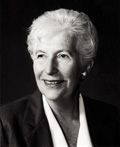
“There are a lot of misconceptions about women in science,” said Phyllis Brown in a 2014 interview (1). At the time, she had just published a book about caring for her husband while he suffered from Alzheimer’s disease, and she was planning to write another book, about her career as a scientist. “I think my next book will be called A Life with the Boys,” she said.
Sadly, Brown passed away before that second book became a reality. This renowned chromatographer died on Wednesday, July 8, 2015, at the age of 91, in Providence, Rhode Island.
In reflecting on Brown and her career, I think about her in two ways. First, I think about her as an outstanding chromatographer, who championed high performance liquid chromatography (HPLC) and showed how it could be used for the analysis of complex real-world samples in fields like biochemistry and medicine-at a time when many were only testing it with simple, clean samples. Equally, I remember her as pioneer who saw the particular challenges faced by women in science and who supported and championed other women in the field.
A Pioneer in HPLC, Applying It to Messy, Real-World Samples
Brown, an excellent scientist and a prolific scientific author who had more than 200 scientific peer-reviewed articles to her credit, was the author of five books in chromatography and capillary electrophoresis (CE), and was a longtime coeditor, with Professor Eli Grushka, of 30 volumes of the much-loved Advances in Chromatography book series. She received a consistent flow of awards for her work. These recognitions include a Fulbright Fellowship, the Tswett Medal in Chromatography, the Dal Nogare Award in Chromatography (she is one of only three women to have won this award since it began almost 50 years ago), the Governor’s Medal for Contributions to Science and Technology in the State of Rhode Island, the Scholarly Achievement Award for Excellence in Research at the University of Rhode Island, a Brown University Citation for Outstanding Research in Chemistry, the Csaba Horváth Medal for Separation Science, and the Eastern Analytical Symposium’s Award for Achievements in Separation Science. She was also a member of LCGC’s Editorial Advisory Board for 27 years, from 1983 to 2010.
Brown received her BS in chemistry from George Washington University. But it was not until her four children had reached ages 9–14 that she went back to get her PhD in chemistry from Brown University, where she later became an assistant research professor. In 1973, she joined the faculty of the University of Rhode Island and was promoted to full professor in 1980, retiring in 2001.
Brown was a pioneer in the application of HPLC and CE to biochemistry and medical research. In the infancy of HPLC in the early 1970s and CE in the early 1980s, she saw the tremendous potential of these techniques for biotechnology and had the foresight to predict that they would open up new horizons in medical research.
Specifically, Brown made significant contributions to separation science in three main areas. One was the development and optimization of HPLC and CE for biotechnology, biochemistry, and pharmaceutical research and for use in clinical chemistry and medicine. The second was the use of these assays for nucleic acid constituents in pharmacology and in investigations of disease processes. The third was in studies of the mechanisms of reversed-phase LC retention of purines, pyrimidines, and their nucleotides.
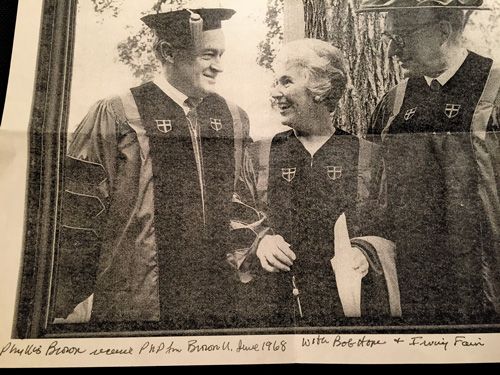
Indeed, an important part of Brown’s pioneering work was her application of HPLC to messy, real-world samples in biochemistry, starting with the first paper she published on the topic in 1970 (2). In a 2012 interview in LCGC (3), Brown talked about her willingness to apply the method to difficult analytical problems at a time when the fact that she was a woman-and an older woman at that, having gone back to get her PhD after raising her children-already made her subject to doubt.
It is a wonder I ever survived as a chromatographer. Almost everyone in the field was an analytical chemist, an engineer, or a physical chemist, and of course they were all male. Along I came, an organic chemist with an interest in biochemistry and pharmacology, and an older woman at that. In addition, they were interested either in the theory of chromatography or in the instrumentation and I was interested in applying their toy to real problems. Their chromatograms, mainly of standards, were neat and clean with nice sharp peaks. My chromatograms of real samples were broad and sloppy looking with peaks of strange sounding compounds. The “old boys” didn’t know what to make of me.
Joy Miksic, who was Phyllis Brown’s first graduate student at URI in 1978, remembers her mentor’s confidence in the value of HPLC during the early days of the technique, in the late 1960s, when it was still very challenging to use. “Those were days of ubiquitous leaks, drifting baselines, 2-hour analysis times, and irreproducible columns,” recalls Miksic, now the principal of Bioanalytical Solutions, LLC. “In spite of those early issues, Phyllis had absolute confidence in the future of HPLC. She offered her help to anyone who had an idea to improve the technique.”
The authority Brown had acquired in the field also impressed Miksic. “When Phyllis walked into a room or a vendor booth, people gathered,” recalls Miksic. “Her enthusiasm and positive energy could be felt loud and clear as she praised the technique and declared it a breakthrough for analysis of biological samples.”
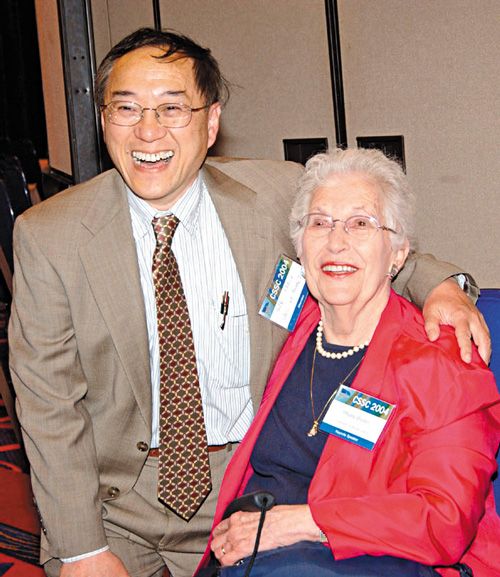
Bob Stevenson, editor emeritus of American Laboratory and a California Separation Science Society Fellow, also valued Brown’s efforts to develop and champion the technique. “‘Mother’ Phyllis was such a great leader in the early days of HPLC,” he said. “I often reflect on the early leaders, especially those who explored and taught the basics. Yes, we have lost a great one.”
A Champion of Women, and All Young Scientists
Brown didn’t just fight to advance HPLC. She learned, early on, the disadvantages she faced as a woman in science, as she realized she was being excluded from the community of the “old boys,” as she explained in that 2012 interview (3):
For the most part, they ignored me. In fact, for several years they didn’t tell me when the HPLC meetings were held. They were mainly by invitation and I didn’t get invited. It took me a while to learn that most of the plans for the coming year were made in the bar in the evenings. By plans, I mean who was going to be invited to speak at next year’s meeting, who they were going to support for awards, editorial boards, and so on. I then learned to go to the bar, sip my drink, and try to be part of “the boys.”
Once she learned what one had to do, she did it. And then she made it a mission to teach those lessons to younger scientists, particularly women, and to support their careers. In particular, she encouraged young women in chromatography to take advantage of the recognition that came from presenting and publishing their work and being visible at scientific meetings.
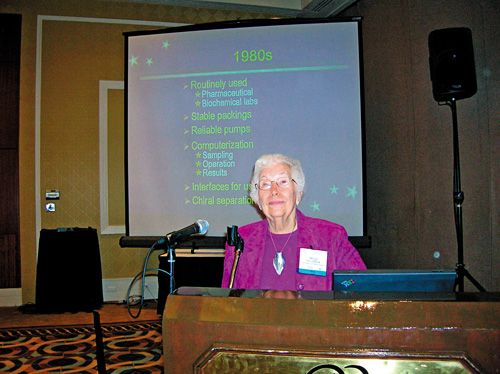
“Phyllis Brown was an extremely knowledgeable analytical chemist and chromatographer, and she generously advised and inspired many younger scientists,” said Peter Schoenmakers, a professor at the University of Amsterdam. “She was a role model for women in chromatography, after struggling many years for full acceptance in a male-dominated field. Phyllis Brown was very willing to share these experiences with younger women as well.”
“Phyllis was a champion of women in science long before the current STEM movement picked up steam,” agreed Patrick D. McDonald, a corporate fellow emeritus at Waters Corporation, who was an undergraduate classmate with Phyllis at Brown University.
And she encouraged all scientists, female or male. “Dr. Brown personally guided and inspired all of us, and everyone she met with love and enthusiasm, inspiring the confidence that we could succeed at anything if we tried hard enough,” remembers Rick Hartwick, who completed both his masters and PhD under Brown at the University of Rhode Island and later cofounded PharmAssist Analytical Laboratory.
Michael Swartz of Boston Analytical sought out Brown to be his PhD advisor, because he knew she had mentored other nontraditional students like him who returned to school having a full-time job or a family, or both. “In your lifetime you will meet only a handful of people that truly make a difference in your life and for me, Dr. Brown is certainly one of those people,” he said. “Her influence in my life and career has, and will continue to have, an everlasting effect.”

John V. Amari, now at the pharmaceutical company Shire, is grateful for the opportunities Brown provided him as a graduate student to learn outside the classroom, through mentoring undergraduates and collaborating with another department. He also remembers her wise words. “She frequently said ‘you never know what you’ll be doing,’” he recalls. “How true that statement was and still is.”
Karyn Usher, an associate professor at Metropolitan State University in St. Paul, Minnesota, also remembers Brown’s sage advice. The first was to never let anyone tell her that she could not achieve her goals. “She also told me that it was important to always look for opportunities and to be open to deviate from my master plan, as long as it felt right,” Usher said. “To this day, I follow this advice and have found it to be quite useful.”
Brown’s support for women, however, went far beyond mentoring.
“Sometimes she acted quietly behind the scenes, and we may not have been aware that she was responsible for our invitations to international symposia or to contribute to special journal issues or books,” noted Vicki McGuffin, professor emerita at Michigan State University. “But at other times she was quite vocal, especially about the need to nominate women for awards. Because of her efforts, women are represented among the recipients of many national and international awards in separation science.”
And some, like Christina Robb, acknowledged that it took time for them to realize the importance of what Brown did for women in science. Robb was Brown’s last PhD student and is now an Assistant Agricultural Scientist II for the Connecticut Agricultural Experiment Station.
“I came from an undergraduate experience where there were lots of women in the physical sciences,” said Robb. “At the time I came to work for Phyllis, in terms of the women in science issue, I didn’t quite connect. However, I realized over the years, I was exactly what she was fighting for.”
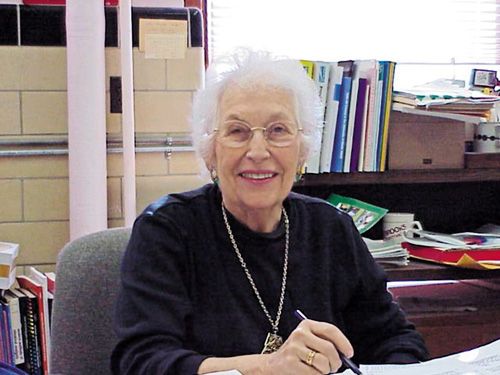
Ron Majors, retired from Agilent, remembers the “Women in Chromatography” luncheon Brown organized at the HPLC ’86 conference in San Francisco that he chaired.
“The restaurant was filled to capacity with nearly every woman at the symposium in attendance and, to my surprise, many noted male chromatographers were there as well-and the food wasn’t free!” he said. “Although there were no formal presentations, the presence of Phyllis and so many women gave a not-so-subtle message about increasing the presence and acceptance of more women in chromatography to an increasingly less skeptical primarily male audience.”
A Short, But Significant Walk
Apryll Stalcup, a professor at the University of Cincinnati and the director of the Irish Separation Science Cluster and Professor of Chemical Sciences at Dublin City University in Ireland, did not attend that luncheon at the 1986 HPLC conference, but she felt its impact-and especially of what Brown did after the luncheon. When it was time to return to the plenary session, Brown arranged to have all the women walk into the room at the same time.
The first time I heard of Phyllis Brown was when I was a graduate student working at NIST. I was the only woman present, having lunch with several very prominent chromatographers. They were all talking about Phyllis organizing all the women chromatographers at a recent conference to enter the room at the same time, and they were wondering what it all meant. I thought this was very interesting because before entering graduate school, I had worked in an environmental lab where the guys with my same level of training got to attend conferences but the company didn’t want to pay for an extra hotel room for me. After I heard this story about what Phyllis Brown did, for the first time, I didn’t feel so alone. I felt that it was ok to be on this path.
I was among the female chromatographers who entered that room together. That was an empowering and pivotal moment. Like Apryll, after that event, I didn’t feel alone anymore. It was just a short walk, and the destination was simply a seat in the room. There were no speeches. But the message was felt: We are here. We matter. We are connected. Phyllis was our gatherer, and her gathering inspired and provoked us.
Brown’s efforts to support women in science, making our presence felt by the men and connecting us to each other, occurred not just in group events like the gesture of entering the room together, but through regular, consistent, and personal support. She weaved the thread of connection consistently, calling to ask about a paper she saw that we published, and concluding the conversation by talking about efforts going on for women scientists. In her discussions, science was first. But the discussion of how we could encourage young women in the field and focus more energies toward enabling women to be more active in the scientific community was never left out. The science was Phyllis’s passion; giving women a voice in science was her goal.
So, thank you, Phyllis Brown, for your great science, the incredible strides you made in taking chromatography to the practical realm of the imperfect sample, and for publishing and continuing to publish your experiments, your learnings, and your theories. But also, thank you for bellying up to the bar and sipping those drinks, for the march into the room, for the countless subsequent women’s lunches you organized at meetings. You made a difference. You connected, you asked, and you pushed and cajoled so that gender would not make a difference in scientific and technological advancement. And you expected us to do the same. We have, we are, we will.
References
(1) http://sdppublishingsolutions.com/author-corner-phyllis-brown-author-of-help-me-im-slipping-talks-about-finding-solace-in-writing-and-her-hope-that-her-book-will-help-caregivers/ (2014).
(2) P.R. Brown, J. Chrom.52, 257 (1970).
(3) K.M. Usher, LCGC North Am.30(11), 982–985 (2012). http://www.chromatographyonline.com/phyllis-brown-story-serendipity-perseverance-vision-and-chromatography.
Mary Ellen P. McNally, PhD, is a Technical Fellow with DuPont Crop Protection at the Stine Haskell Research Center in Newark, Delaware. She is an editorial advisory board member of LCGC North America. Direct correspondence to: Mary-Ellen.McNally@dupont.com
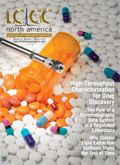
Evaluating Natural Preservatives for Meat Products with Gas and Liquid Chromatography
April 1st 2025A study in Food Science & Nutrition evaluated the antioxidant and preservative effects of Epilobium angustifolium extract on beef burgers, finding that the extract influenced physicochemical properties, color stability, and lipid oxidation, with higher concentrations showing a prooxidant effect.
Rethinking Chromatography Workflows with AI and Machine Learning
April 1st 2025Interest in applying artificial intelligence (AI) and machine learning (ML) to chromatography is greater than ever. In this article, we discuss data-related barriers to accomplishing this goal and how rethinking chromatography data systems can overcome them.
Study Examines Impact of Zwitterionic Liquid Structures on Volatile Carboxylic Acid Separation in GC
March 28th 2025Iowa State University researchers evaluated imidazolium-based ZILs with sulfonate and triflimide anions to understand the influence of ZILs’ chemical structures on polar analyte separation.













